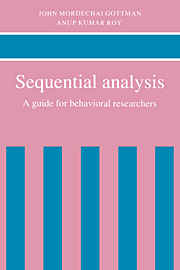Chapter 1 - Advertisement
from Part I - Introduction
Published online by Cambridge University Press: 10 November 2009
Summary
This chapter is essentially an advertisement for the sequential and time-series analysis of observational data. We would go so far as to make the statement: Anyone who has collected data over time and ignores time is missing an opportunity. We would like to back up this statement with several examples and with a discussion of conceptual issues.
The substantive theoretical discussion in this chapter concerns the analysis of marital and family interaction. Perhaps the most exciting area in which sequential analysis has been applied is social interaction. Sequential analysis, we will see, has supplied a great many analytic tools for researchers studying social interaction. It is not a mere data analysis option. It is a whole new way of thinking about social processes. The dimension of time is so central to conceptualizing social interaction that its use will lead us to think of interaction itself as temporal form.
We will begin with a few examples. The first is metacommunication, a concept introduced in what has become known as the “doublebind” paper (Bateson et. al., 1957). A metacommunication qualifies or comments on communication. It can be a nonverbal act that says “all that follows is really play,” or it can be a statement that comments on the process of communication, such as, “you're interrupting me,” or “that's not what we were discussing.”
- Type
- Chapter
- Information
- Sequential AnalysisA Guide for Behavorial Researchers, pp. 3 - 8Publisher: Cambridge University PressPrint publication year: 1990



